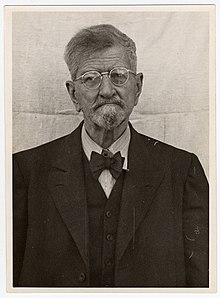Claus Schilling
Claus Karl Schilling (also written as Klaus ; * July 5, 1871 in Munich ; † May 28, 1946 in Landsberg am Lech ) was a doctor of tropical medicine from Germany and had a research station in the Dachau concentration camp .
Life
Schilling studied with Robert Koch in Berlin and has been researching and fighting malaria since 1898 . Before that, from 1896, he worked as a family doctor at the German Hospital (London) for a few years . After working as a colonial doctor in Togo and German East Africa , from 1905 he was director of the tropical medicine department at the Robert Koch Institute . He held this position until his retirement as professor in 1936. Since the 1920s, Schilling had been involved in serological experiments on psychiatric patients at Italian sanatoriums and in Berlin. In Rome in November 1941, Schilling met the “Reich Health Leader” Leonardo Conti , who, at Heinrich Himmler's behest, entrusted him with continuing his experiments to find a cure for malaria in the Dachau concentration camp .
From February 1942, when he was over 70, Schilling began his research in the concentration camp. He carried out inhuman experiments on more than 1,000 prisoners by exposing test subjects to infected mosquitoes or injecting an extract from their salivary glands in order to develop a vaccine against malaria. One of these test objects was z. B. the Catholic priest Fritz Keller . Schilling also tested the synthetic anti-malarial drug “Boehringer 2516” on prisoners. They called him "blood shilling". At the beginning, the victims of his experiments were mainly Polish clergymen, later also imprisoned Italians and Russians. Around 30 people died directly as a result of the attempts, around 300 to 400 later became victims of the aftermath. The experiments were not stopped until April 5, 1945 by order of Himmler. Schilling's assistant doctors were initially Rudolf Brachtel and, from April 1943 to mid-1944, Kurt Plötner .
After the liberation of the concentration camp, Schilling was charged with 39 other defendants on November 15, 1945 in the main Dachau trial. In this first Dachau trial , he was sentenced to death on December 13, 1945 . In the judgment, the responsibility for pseudo-medical experiments with malaria pathogens on more than 1,000 prisoners as well as the independent implementation of malaria experiments on prisoners, some of whom died as a result, were taken into account as individual acts of excess in Schilling . In a personal statement on December 31, 1945, Nobel Prize laureate Privy Councilor Heinrich Wieland stated that he had the impression “that he [Schilling], as a real researcher, is passionately pursuing his scientific goal. He made no secret of the fact that for him the cooperation with instances of the party, whose outspoken opponent he was, meant a heavy sacrifice, which he had to make for the sake of the cause ”.
The death penalty was carried out on May 28, 1946 by hanging in the Landsberg War Crimes Prison .
He made contributions on tropical diseases to the manual of internal medicine (Volume 1) in the 1st and 2nd edition (1911 and 1925 respectively).
literature
- Ernst Klee : The personal lexicon for the Third Reich - who was what before and after 1945. 2nd edition. Fischer-Taschenbuch-Verlag, Frankfurt am Main 2007, p. 535.
- Ernst Klee: Auschwitz, Nazi medicine and its victims. 3. Edition. Fischer-Taschenbuch-Verlag, Frankfurt am Main 1997, ISBN 3-596-14906-1 .
- Holger Lessing: The first Dachau trial (1945/46). Nomos, Baden-Baden 1993, ISBN 3-7890-2933-5 .
- Case No. 000-50-2 (US vs. Martin Gottfried Weiss et al.) Tried 13 Dec. 45 ( PDF file; 39.0 MB; English ).
Web links
- Literature by and about Claus Schilling in the catalog of the German National Library
- Barbara Diestel, Wolfgang Benz : The Dachau Concentration Camp 1933-1945. History and meaning . Ed .: Bavarian State Center for Political Education. Munich 1994 ( Medical experiments in the Dachau concentration camp ( memento of December 3, 2005 in the Internet Archive ) [accessed on January 18, 2007]).
swell
- ↑ Jürgen Püschel: The history of the German Hospital in London (1845 to 1948) (studies on the history of the hospital system 14) . Münster 1980, p. 135.
- ^ A b Ernst Klee: Auschwitz, Nazi medicine and its victims. Frankfurt am Main, 1997, pp. 117f.
- ^ A b Barbara Diestel, Wolfgang Benz: The Dachau Concentration Camp 1933 - 1945. History and meaning . Ed .: Bavarian State Center for Political Education. Munich 1994 ( Medical experiments in the Dachau concentration camp ( memento of December 3, 2005 in the Internet Archive ) [accessed on January 18, 2007]). The Dachau Concentration Camp 1933 - 1945. History and significance ( Memento of the original from December 3, 2005 in the Internet Archive ) Info: The archive link was inserted automatically and has not yet been checked. Please check the original and archive link according to the instructions and then remove this notice.
- ↑ List of test persons, malaria test station in KL Dachau, ITS, Arolsen, archive of the Dachau Concentration Camp Memorial, No. 5793.
- ^ Christian Frieling: Priest from the diocese of Münster in the concentration camp . Aschendorff Verlag, Münster 1992, ISBN 3-402-05427-2 , p. 77.
- ^ Archives of the Dachau Concentration Camp Memorial Site, No. 3297.
- ^ Holger Lessing: The first Dachau trial (1945/46). Baden-Baden 1993, p. 320.
- ^ Ernst Klee: The dictionary of persons on the Third Reich . Who was what before and after 1945. Frankfurt am Main 2007, p. 535
| personal data | |
|---|---|
| SURNAME | Schilling, Claus |
| ALTERNATIVE NAMES | Klaus |
| BRIEF DESCRIPTION | German tropical medicine specialist and active in the Dachau concentration camp |
| DATE OF BIRTH | July 5, 1871 |
| PLACE OF BIRTH | Munich |
| DATE OF DEATH | May 28, 1946 |
| Place of death | Landsberg am Lech |

